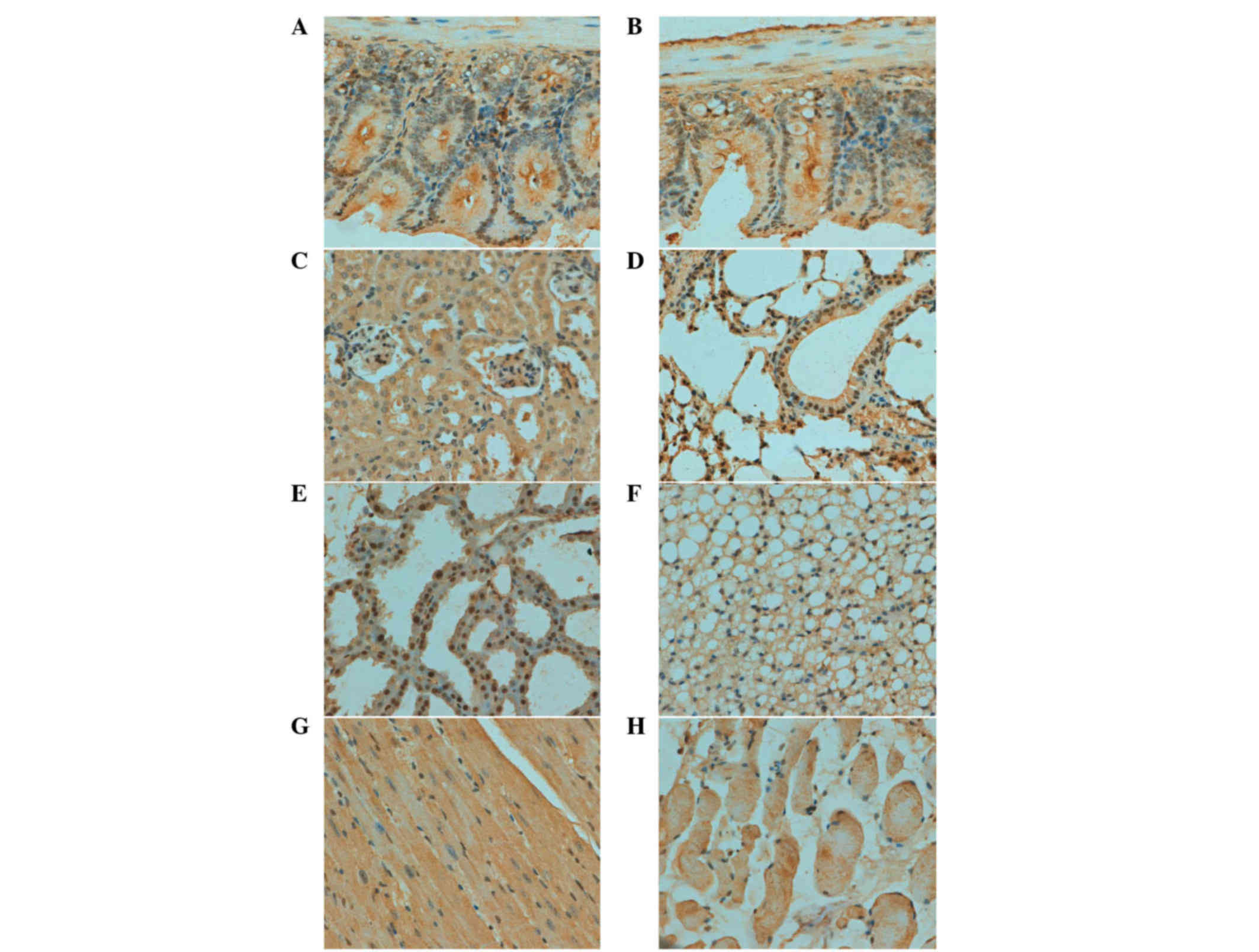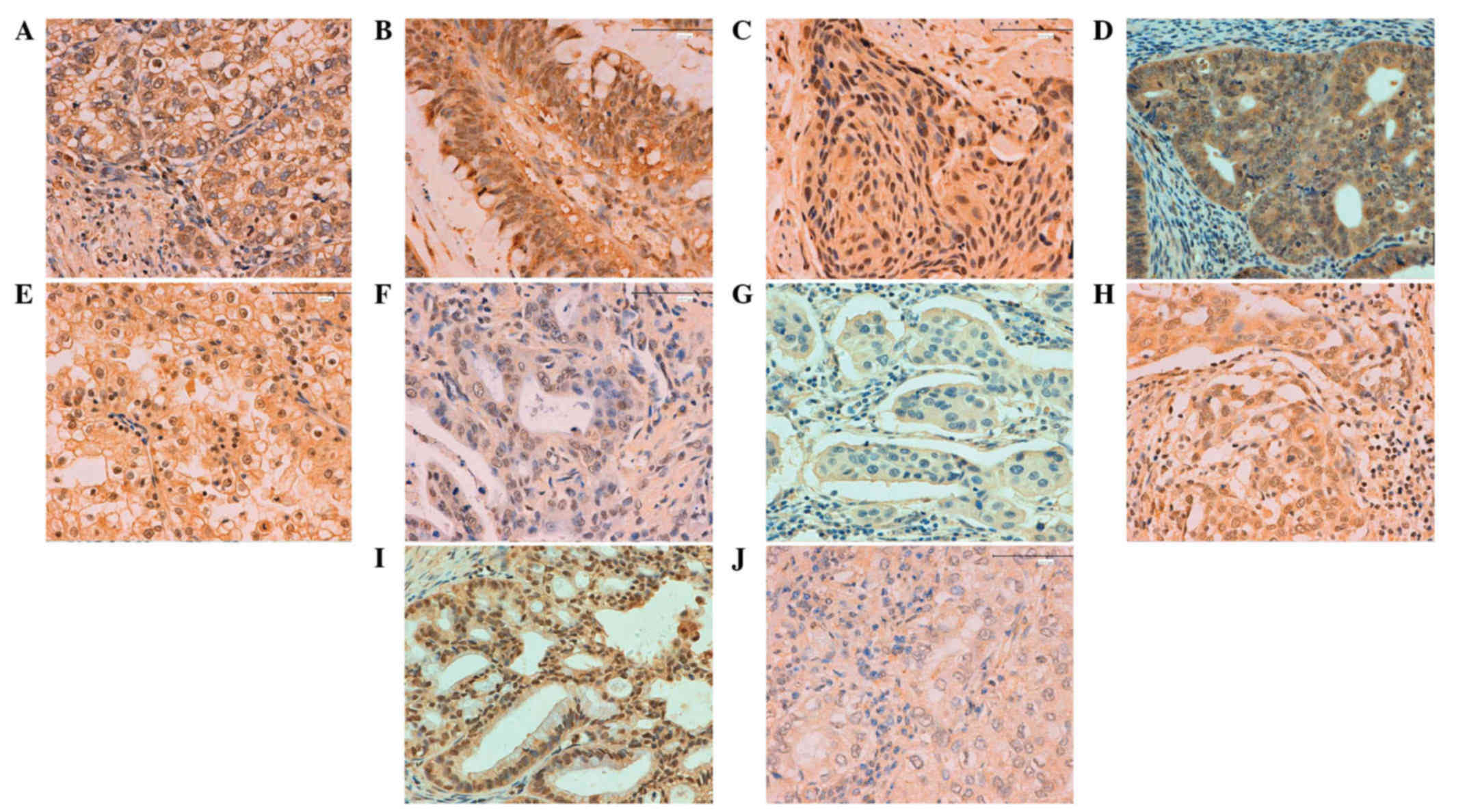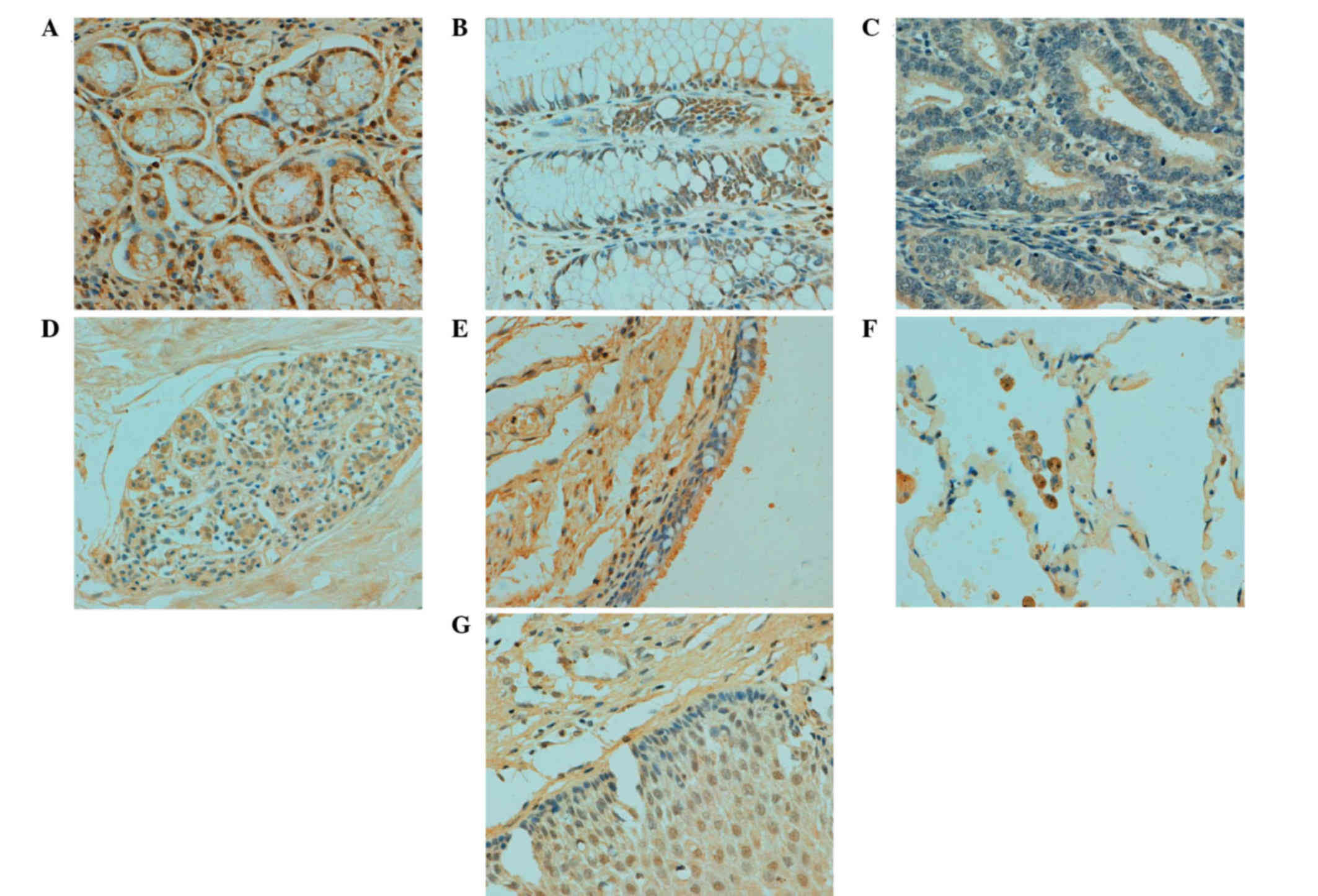Immunohistochemical profile of ING3 protein in normal and cancerous tissues
- Authors:
- Published online on: January 23, 2017 https://doi.org/10.3892/ol.2017.5632
- Pages: 1631-1636
-
Copyright: © Gou et al. This is an open access article distributed under the terms of Creative Commons Attribution License.
Abstract
Introduction
The inhibitor of growth (ING) family consists of five members with various isoforms due to alternative splicing. Their encoded proteins comprise a highly conserved plant homeodomain (PHD), a Cys4-His-Cys3 form of zinc finger that interacts directly with histone H3, and a nuclear localization sequence (NLS). ING proteins act as receptors and transducers of stress-activated phosphoinositides, inhibit angiogenesis, promote cellular senescence or are involved in various biological processes, including DNA repair, apoptosis, cell cycle checkpoints, histone methylation and acetylation, and regulation of transcription by protein-protein or protein-DNA interaction. They appear to be inactivated in malignancies and therefore are classified as class II tumor suppressor genes (1,2).
The human ING3 gene is located at chromosome 7q31.3, is composed of 12 exons and produces three proteins (Fig. 1), among which p47ING3 controls p53-mediated transcription, blocks cell cycle control and induces apoptosis (3). As a significant chromatin acetylation regulator, ING3 is primarily involved in the formation of nucleosome NuA4 histone acetyltransferase multi-subunit complex and is essential for the histone acetyltransferase activity of Tip60 (2,4). ING3 overexpression decreases the S-phase population of cells and their colony-forming ability, and induces apoptosis in RKO human colon carcinoma cells in a p53-mediated manner (5). An additional study has indicated that ING3 activates p53-transactivated promoters of p21 and Bcl2-associated X protein (5). In addition, ING3 has been demonstrated to be capable of enhancing ultraviolet-induced apoptosis of melanoma cells via a Fas/caspase-8-dependent signaling pathway, independently of functional p53 (6). Furthermore, it was identified that ING3 underwent degradation via its interaction with subunits of E3 ligase Skp1-Cullin-F-box (SCF) protein complex in the ubiquitin-proteasome signaling pathway, which provided an alternative explanation for ING3 downregulation (7). ING3 may also be capable of regulating asymmetric cell division via the mammalian target of rapamycin signaling pathway during mouse oocyte maturation (8).
ING3 mRNA is ubiquitously expressed in normal human tissues, including the testes, skeletal muscle, spleen, heart and oral mucosa (5). Nuclear ING3 expression is markedly reduced in malignant melanoma compared with dysplastic nevi, and is significantly associated with a poorer prognosis for melanoma as an independent factor (9). Gunduz et al (10) demonstrated that loss of heterozygosity (LOH) resulted in reduced ING3 expression in human head and neck squamous cell carcinomas (HNSCC). A previous survival analysis revealed that ING3 downregulation may be considered as an independent prognostic factor for poor overall survival time in HNSCC (11). In addition, Borkosky et al (12) identified that SSLOH of the ING3 locus was high in solid type tumors of ameloblastoma. mRNA and protein concentrations of ING3 have been observed to be downregulated in the majority of hepatocellular carcinoma (HCC) cases in comparison with matched non-tumor hepatic tissues, and reduced expression of ING3 protein is correlated with more aggressive characteristics and adverse prognosis in this tumor type (13,14). Consistently, ectopic ING3 overexpression in HCC cells was observed to suppress colony formation, cell proliferation and migration (13,14). These results suggest that reduced ING3 expression may be associated with tumorigenesis and the subsequent development of malignancies. Thus, the present study analyzed the expression profile of ING3 protein in normal mouse and human tissues, and in human cancer tissues.
Materials and methods
Samples
A total of three male and three female C57BL/6 mice (8 weeks old; 30–40 g) were maintained under specific pathogen-free conditions in a temperature-controlled room with a 12-h light/dark illumination cycle. Standard rodent food and water were supplied ad libitum. Housing and all procedures were performed according to guidelines on animal welfare approved by the Committee for Animal Experiments of Liaoning Medical University. The mice were sacrificed under sodium pentobarbital anesthesia, and tissue samples were dissected from the brain, heart, liver, spleen, lung, kidney, breast, stomach and intestine. All tissues were fixed in 10% neutral formalin, embedded in paraffin and cut into 4-µm sections. The tissue arrays of human normal tissues (cerebrum, cerebellum, brain stem, aorta, tongue, thyroid, esophagus, stomach, intestine, liver, pancreas, lung, trachea, appendix, smooth muscle, skeletal muscle, heart, testis, bladder and prostate) and cancer tissues (62 hepatocellular carcinoma, 62 renal clear cell carcinoma, 62 pancreatic carcinoma, 45 esophageal squamous cell carcinoma and 31 cervical squamous cell carcinoma cases) were purchased from Shanghai Outdo Biotech Co., Ltd (Shanghai, China). Human cervix, endometrium, ovary and breast tissues were sampled from surgical patients at The First Affiliated Hospital of Liaoning Medical University (Jinzhou, China). In addition, breast (n=144), gastric (n=196), colorectal (n=96), ovarian (n=208), endometrial (n=96) and lung carcinoma (n=192) samples were collected from patients at the same hospital. Dissected mouse tissues and collected human normal and cancer tissues, were subjected to tissue microarray using a tissue microarrayer (AZUMAYA KIN-1; Azumaya Corporation, Tokyo, Japan). None of the cancer patients had undergone chemotherapy, radiotherapy or adjuvant treatment prior to surgery. The patients or their relatives provided written consent for the use of tumor tissues for clinical research, and the research protocol was approved by the Ethical and Animal Experimentation Committees of Liaoning Medical University (Jinzhou, China).
Immunohistochemistry
Consecutive sections were dewaxed using xylene, rehydrated in a graded series of alcohol to water, and subjected to antigen retrieval by irradiation in target retrieval solution (Dako North America, Inc., Carpinteria, CA, USA) in a microwave oven for 15 min (Oriental Rotor Ltd., Co., Tokyo, Japan). Sections were subsequently blocked with 5% bovine serum albumin (A8020; Beijing Solarbio Science & Technology Co., Ltd., Beijing, China) for 20 min to prevent non-specific antibody binding. The sections were incubated with rabbit polyclonal IgG anti-ING3 (#sc-366026; Santa Cruz Biotechnology, Inc., Dallas, TX, USA; dilution, 1:50) for 15 min, followed by incubation with the secondary anti-rabbit polyclonal Ig antibody conjugated to horseradish peroxidase (HRP) (#P0399; HRP; Dako North America, Inc.; ready-to-use) for 60 min. Following each treatment, the slides were washed using Tris-buffered saline and Tween 20 (TBST; 3 × 1-min washes). The HRP was colored with 3,3′-diaminobenzidine. Sections were counterstained using Mayer's hematoxylin, dehydrated, cleared and mounted. TBST was utilized as a negative control in place of primary antibody.
Immunohistochemical evaluation
As indicated in Figs. 2–4, ING3 immunopositivity was localized to the cytoplasm and/or nucleus. Initially, a strong expression field was selected under low magnification and all cells were randomly counted in five different representative fields of each section, which were assessed blindly by two independent pathologists. Any inconsistent data was discussed by the pathologists until a final agreement was reached. The percentages of counted cells (calculated as the mean percent of positively stained cells out of the total cells counted) were scored as follows: 0–10%, negative (−), 11–100%, positive (+).
Results
ING3 is detectable in a wide range of cell types in mice
As indicated in Fig. 2, ING3 protein was positively detected in the cytoplasm of cardiomyocyte, kidney and skeletal muscle cells. A cytoplasmic and nuclear distribution of ING3 protein was observed in bronchial and alveolar epithelium, gastric, intestinal and mammary gland cells. ING3 protein was expressed in the brain, spleen, skin and liver in a sporadic manner (Table I).
Table I.Immunohistochemical examination of inhibitor of growth family, member 3 protein in mouse normal tissues. |
ING3 expression is primarily localized to the cytoplasm in normal human tissues
In human tissues, ING3 protein was principally distributed in the cytoplasm; however, it was observed in both the cytoplasm and nucleus of tongue, esophagus, stomach, intestine, lung, skin, appendix, bladder, cervix and breast cells (Table II; Fig. 3). According to the density, ING3 immunoreactivity was strongly detected in stomach, skin and cervical cells, and was weakly detected in cerebellum, brain stem, thymus, liver, skeletal muscle, testis and prostate cells (data not shown).
ING3 is most frequently expressed in gynecological types of cancer
In total, ING3-positivity was identified in 424 of 1,194 tested cancer entities (35.5%), with a homogeneous expression pattern (Fig. 4; Table III). In the majority of cases, ING3 expression was observed to be distributed in the cytoplasm and nucleus, with the exception of the cytoplasmic distribution in breast and hepatocellular carcinoma. Among the cancer entities studied, ING3 was most frequently expressed in cases involving female cancer types, including ovarian (59.2%; 124/208), endometrial (47.9%; 46/96), breast (38.9%; 56/144) and cervical cancers (35.5%; 11/31). ING3-positive cases were more rare in renal clear cell (17.7%; 11/62), hepatocellular (16.1%; 10/62) and esophageal carcinomas (17.8%; 8/45).
Discussion
ING3 protein contains an NLS and a PHD finger motif at the C-terminus (15). Previously, Wang et al (9) demonstrated that nuclear-to-cytoplasmic translocation of ING3 protein led to reduced nuclear expression in cutaneous melanoma. The degradation of ING3 by the cytoplasmic SCF (S-phase kinase-associated protein 2)-mediated ubiquitin-proteasome system provided additional evidence for its cytosolic localization (7). An additional two studies observed a cytoplasmic expression pattern of ING3 in hepatocytes and HCC (13,14). In the present study, the expression level and cellular localization of ING3 protein was characterized in normal mouse and human tissue, and human cancer tissue. A positive ING3 signal was observed in the cytoplasm of normal mouse and human tissue, and in human cancer tissue, and was occasionally observed in both the cytoplasm and nucleus. Cenzig et al (16) reported that the mutation or deletion of the ING5 NLS resulted in its nucleocytoplasmic translocation. ING1 phosphorylation by 14-3-3 family (17) or Src (18) proteins leads to its cytoplasmic relocalization for apoptotic induction. Therefore, it was speculated that chemical modification of ING3 may lead to its restoration in the cytoplasm, which will require clarification in future studies.
Amino acid sequence alignment has demonstrated a high similarity between human p47ING3 and mouse ING3, revealing that they share 95% identity (1). Consistently, the present study identified no notable differences in the patterns of ING3 expression between mouse and human samples. In human tissue, ING3 protein was strongly detected in stomach, skin and cervical cells, and was weakly detected in brain, thymus, liver, skeletal muscle, testis and prostate cells, suggesting a functional involvement of ING3 in distinct cell types and in the specific functional state of cells. Therefore, in future studies, we aim to conditionally ablate the ING3 gene using a cell-specific promoter and establish an animal model of ING3-negative tumors. In the relevant literature, ectopic ING3 expression resulted in increased apoptosis via the Fas-mediated signaling pathway (6) and suppression of proliferation (5). Therefore, ING3 overexpression in the stomach, skin and cervix may be associated with regeneration and repair, regardless of whether glandular or squamous epithelium; this is supported by the observed weaker expression in organs with low levels of repair and renewal, including the brain, thymus, skeletal muscle and testis. Notably, ING2, another member of the ING family, has been reported to be involved in muscle differentiation via regulating myogenin transcription (19). As a member of the ING family, ING3 protein is enriched in heart, skeletal and smooth muscle cells, which is hypothesized to be associated with the differentiation of muscles.
ING3 is a candidate tumor suppressor gene, and its expression is frequently downregulated in tumors (9,14,15). The present study focused on the most commonly occurring epithelial cancers and demonstrated that female types of cancer, including breast, ovarian and endometrial, exhibited higher levels of ING3 expression, indicating that ING3 protein may be involved in estrogen production or may be regulated by estrogen. It was notable that gastric and colorectal cancers demonstrated similar levels and patterns of expression of ING3, which may be due to the similar carcinogenesis and pathological behaviors of these types of cancer. By contrast, renal clear cell carcinoma demonstrated the lowest levels of ING3 expression, with a positive rate of <20%. This knowledge may significantly facilitate the identification of cancer patients that may potentially benefit from an ING3-targeting gene therapy. According to the relevant literature, ING3 protein is involved in the modulation of p53-mediated transcription, cell cycle control and apoptosis (1,2). In RKO human colon carcinoma cells, ING3 overexpression reduced colony formation, potentially by reducing the number of cells in S phase (5). In combination with these findings, the profiling of ING3 expression may assist with clarification of the role of ING3 expression in disruption of proliferation and apoptosis in various types of epithelial cancer.
In summary, the present study clarified the differential expression and/or subcellular location of ING3 in various tissues, cell types and single cells in normal mouse and human tissues, and human cancer tissue, suggesting differential functional involvement. Based on the results of the present study, it is hypothesized that ING3 may be involved in the repair and regeneration of organs or tissues, and may have a significant role in gynecological carcinogenesis.
Acknowledgements
This study was supported by the Liaoning BaiQianWan Talents Program, a Key Scientific and Technological Project of Liaoning Province (grant no. 2015408001), Scientific Research Fund of Liaoning Provincial Education Department (grant no. LJQ2014093) and the National Natural Science Foundation of China (grant nos. 81172371, 81472544 and 81672700).
References
|
Ludwig S, Klitzsch A and Baniahmad A: The ING tumor suppressors in cellular senescence and chromatin. Cell Biosci. 1:252011. View Article : Google Scholar : PubMed/NCBI | |
|
Doyon Y, Cayrou C, Ullah M, Landry AJ, Côté V, Selleck W, Lane WS, Tan S, Yang XJ and Côté J: ING tumor suppressor proteins are critical regulators of chromatin acetylation required for genome expression and perpetuation. Mol Cell. 21:51–64. 2006. View Article : Google Scholar : PubMed/NCBI | |
|
Guérillon C, Bigot N and Pedeux R: The ING tumor suppressor genes: Status in human tumors. Cancer Lett. 345:1–16. 2014. View Article : Google Scholar : PubMed/NCBI | |
|
Ullah M, Pelletier N, Xiao L, Zhao SP, Wang K, Degerny C, Tahmasebi S, Cayrou C, Doyon Y, Goh SL, et al: Molecular architecture of quartet MOZ/MORF histone acetyltransferase complexes. Mol Cell Biol. 28:6828–6843. 2008. View Article : Google Scholar : PubMed/NCBI | |
|
Nagashima M, Shiseki M, Pedeux RM, et al: A novel PHD-finger motif protein, p47ING3, modulates p53-mediated transcription, cell cycle control, and apoptosis. Oncogene. 22:343–350. 2003. View Article : Google Scholar : PubMed/NCBI | |
|
Wang Y and Li G: ING3 promotes UV-induced apoptosis via Fas/caspase-8 pathway in melanoma cells. J Biol Chem. 281:11887–11893. 2006. View Article : Google Scholar : PubMed/NCBI | |
|
Chen G, Wang Y, Garate M, Zhou J and Li G: The tumor suppressor ING3 is degraded by SCF(Skp2)-mediated ubiquitin-proteasome system. Oncogene. 29:1498–1508. 2010. View Article : Google Scholar : PubMed/NCBI | |
|
Suzuki S, Nozawa Y, Tsukamoto S, Kaneko T, Imai H and Minami N: ING3 is essential for asymmetric cell division during mouse oocyte maturation. PLoS One. 8:e747492013. View Article : Google Scholar : PubMed/NCBI | |
|
Wang Y, Dai DL, Martinka M and Li G: Prognostic significance of nuclear ING3 expression in human cutaneous melanoma. Clin Cancer Res. 13:4111–4116. 2007. View Article : Google Scholar : PubMed/NCBI | |
|
Gunduz M, Ouchida M, Fukushima K, Ito S, Jitsumori Y, Nakashima T, Nagai N, Nishizaki K and Shimizu K: Allelic loss and reduced expression of the ING3, a candidate tumor suppressor gene at 7q31, in human head and neck cancers. Oncogene. 21:4462–4470. 2002. View Article : Google Scholar : PubMed/NCBI | |
|
Gunduz M, Beder LB, Gunduz E, Nagatsuka H, Fukushima K, Pehlivan D, Cetin E, Yamanaka N, Nishizaki K, Shimizu K and Nagai N: Downregulation of ING3 mRNA expression predicts poor prognosis in head and neck cancer. Cancer Sci. 99:531–538. 2008. View Article : Google Scholar : PubMed/NCBI | |
|
Borkosky SS, Gunduz M, Beder L, Tsujigiwa H, Tamamura R, Gunduz E, Katase N, Rodriguez AP, Sasaki A, Nagai N and Nagatsuka H: Allelic loss of the ING gene family loci is a frequent event in ameloblastoma. Oncol Res. 18:509–518. 2010. View Article : Google Scholar : PubMed/NCBI | |
|
Lu M, Chen F, Wang Q, Wang K, Pan Q and Zhang X: Downregulation of inhibitor of growth 3 is correlated with tumorigenesis and progression of hepatocellular carcinoma. Oncol Lett. 4:47–52. 2012.PubMed/NCBI | |
|
Yang HY, Liu HL, Tian LT, Song RP, Song X, Yin DL, Liang YJ, Qu LD, Jiang HC, Liu JR and Liu LX: Expression and prognostic value of ING3 in human primary hepatocellular carcinoma. Exp Biol Med (Maywood). 237:352–361. 2012. View Article : Google Scholar : PubMed/NCBI | |
|
Shah S, Smith H, Feng X, Rancourt DE and Riabowol K: ING function in apoptosis in diverse model systems. Biochem Cell Biol. 87:117–125. 2009. View Article : Google Scholar : PubMed/NCBI | |
|
Cengiz B, Gunduz E, Gunduz M, Beder LB, Tamamura R, Bagci C, Yamanaka N, Shimizu K and Nagatsuka H: Tumor-specific mutation and downregulation of ING5 detected in oral squamous cell carcinoma. Int J Cancer. 127:2088–2094. 2010. View Article : Google Scholar : PubMed/NCBI | |
|
Gong W, Russell M, Suzuki K and Riabowol K: Subcellular targeting of p33ING1b by phosphorylation-dependent 14-3-3 binding regulates p21WAF1 expression. Mol Cell Biol. 26:2947–2954. 2006. View Article : Google Scholar : PubMed/NCBI | |
|
Yu L, Thakur S, Leong-Quong RY, Suzuki K, Pang A, Bjorge JD, Riabowol K and Fujita DJ: Src regulates the activity of the ING1 tumor suppressor. PLoS One. 8:e609432013. View Article : Google Scholar : PubMed/NCBI | |
|
Eapen SA, Netherton SJ, Sarker KP, Deng L, Chan A, Riabowol K and Bonni S: Identification of a novel function for the chromatin remodeling protein ING2 in muscle differentiation. PLoS One. 7:e406842012. View Article : Google Scholar : PubMed/NCBI |













